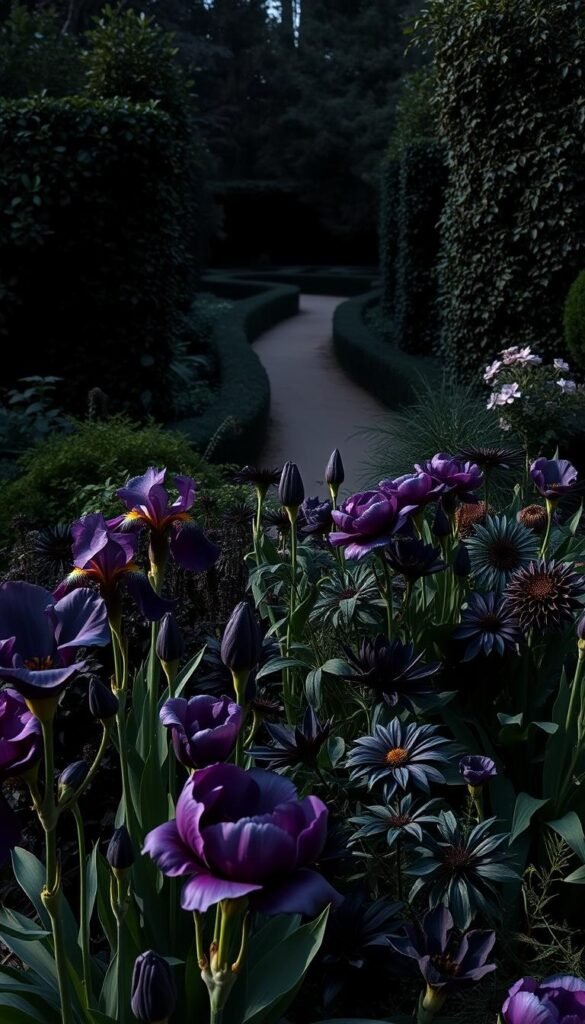Imagine turning your backyard into a living canvas where deep burgundy petals and midnight-purple leaves become your boldest brushstrokes. These richly colored plants act like nature’s neutral palette, harmonizing bright yellows while making pale pinks pop with new intensity. Whether you’re drawn to gothic drama or modern minimalism, these moody hues add instant sophistication.
Dark blooms work like fashion staples in your landscape. They anchor chaotic color schemes or create striking monochromatic displays. Picture velvety ‘Black Barlow’ columbines nodding beside silvery artemisia – a combination that whispers mystery while shouting style.
Planning is key for success with these unconventional beauties. Many thrive in black flower gardens when paired with metallic accents or soft pastels. You’ll discover how staggered bloom times maintain visual intrigue from spring’s first tulips to autumn’s final dahlias.
Friends might gasp when they spot your inky irises contrasting with lime-green hostas. These living artworks don’t just grow – they perform, shifting moods with the light and seasons. Ready to trade predictable petals for something truly unforgettable?
The Allure of Dark Blooms and Bold Foliage
Step into a garden where darkness blooms, crafting tales of rebirth and enigmatic beauty. These shadow-kissed plants do more than grow – they transform spaces through layered meaning and visual magnetism.
Symbolism and Modern Aesthetic
While some associate dark petals with mystery, they’ve symbolized renewal across cultures for centuries. A landscape designer notes: “These aren’t just flowers – they’re living metaphors. Clients often use them to mark personal transformations.”
Their versatility shines through in this comparison:
| Garden Style | Recommended Pairing | Effect Created |
|---|---|---|
| Modern Minimalist | Silver foliage | Moonlit contrast |
| Cottage Charm | Lime-green hostas | Electric vibrancy |
| Gothic Romance | Blood-red roses | Dramatic tension |
Why Black Adds Drama to Your Landscape
Dark petals act like nature’s velvet curtain, making neighboring colors appear more vivid. You’ll notice bees still visit your ‘Black Beauty’ hollyhocks as eagerly as sun-yellow marigolds. This unexpected pollinator appeal adds life to the moody aesthetic.
For maximum impact, position inky irises where morning light backlights their petals. The result? A stained-glass effect that evolves throughout the day. Whether used sparingly or en masse, these blooms ensure your landscape always makes a statement.
Essential Garden Conditions: Full Sun, Well-Drained Soil, and More
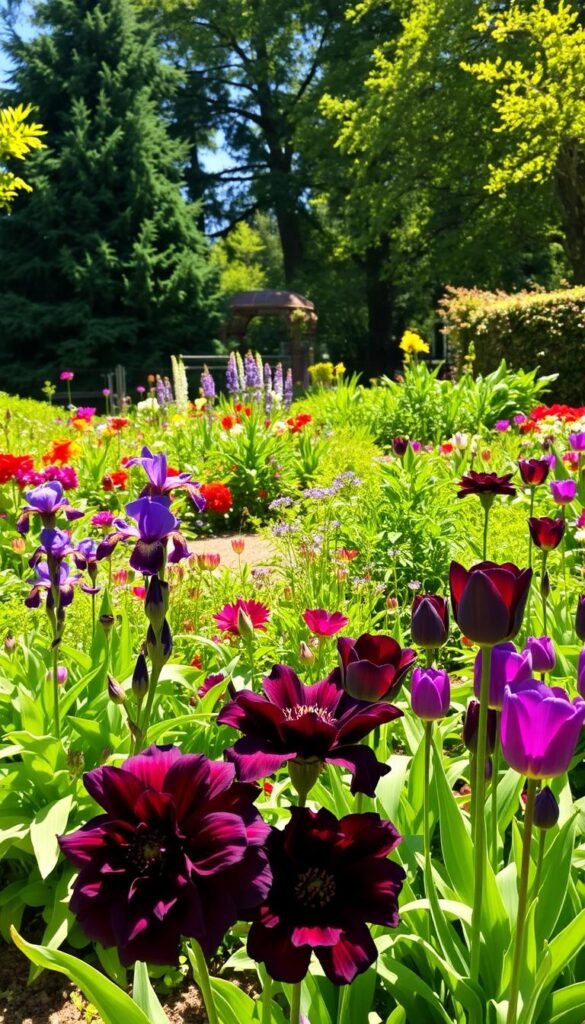
Transform your outdoor space into a shadow-kissed paradise by mastering two critical elements: sunlight and earth composition. These unconventional beauties demand specific care to develop their signature depth of color while resisting common garden pests.
Choosing the Perfect Spot for Your Garden
Your plant’s performance starts with smart real estate choices. Most varieties crave 6-8 hours of direct sunlight daily to intensify their pigments. Scout areas that catch morning rays and afternoon light without shade interruptions.
Microclimates matter more than you might think. Sloped beds or raised planters naturally shed excess moisture, protecting roots from rot. Urban gardeners often find south-facing walls ideal for heat-loving specimens like chocolate cosmos.
Soil Preparation and Light Considerations
Test drainage by digging a 12-inch hole and filling it with water. If it takes over an hour to drain, mix in compost or coarse sand. This creates the well-drained soil conditions dark blooms need to thrive.
While Black Magic elephant ear tolerates part shade, most varieties demand full sun exposure. Balance your layout by grouping sun-lovers together and reserving shaded corners for adaptable foliage plants.
Designing with Contrast: Focal Points and Bold Arrangements
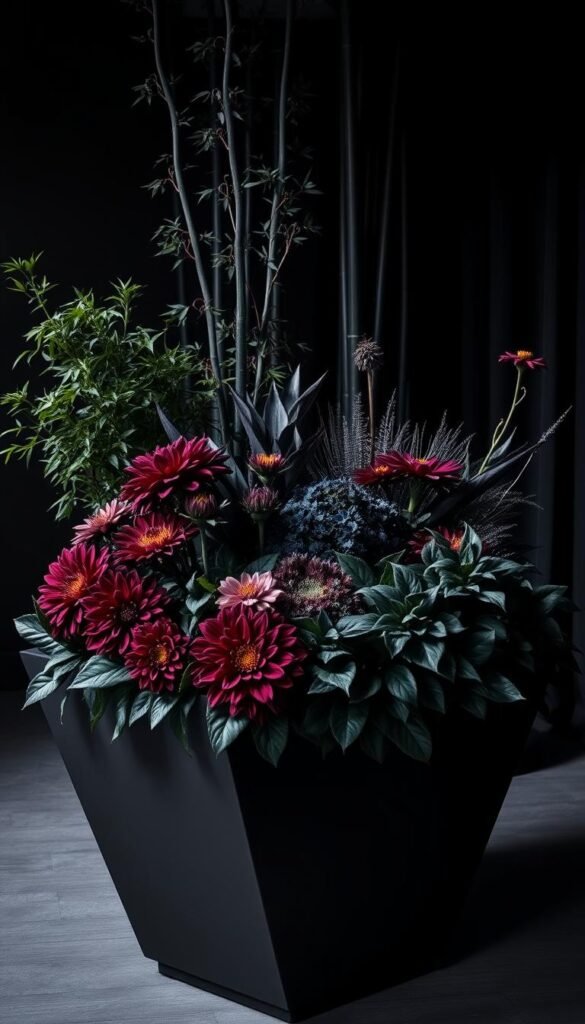
Black serves as nature’s ultimate design tool, transforming ordinary spaces into living art installations. Strategic placement of dark blooms creates depth while letting neighboring colors shine brighter. This section reveals how to use shadowy hues as your secret weapon for unforgettable displays.
Using Containers and Hanging Baskets
Elevate your patio game with midnight-colored planters. Black pots make chartreuse sweet potato vines glow like neon signs against twilight. Try these winning combinations:
| Container Type | Plant Pairing | Visual Effect |
|---|---|---|
| Tall Urn | Black Velvet petunia + Silver dichondra | Waterfall of contrast |
| Hanging Basket | Trailing black nasturtium + Golden creeping Jenny | Living jewelry |
| Window Box | Inky hellebores + White alyssum | Monochrome magic |
For hanging baskets, mix slow-release fertilizer into potting soil. This keeps trailing petunias blooming vigorously all season. Position baskets at eye level where their dark petals can catch sunlight from multiple angles.
Creating Striking Borders and Beds
Frame your pathways with alternating bursts of darkness and light. Plant black hollyhocks behind pale pink phlox for a layered effect. In raised beds, use dark blooms as punctuation marks between colorful sections.
Try this border formula for instant drama:
- Back row: 3-5 ft dark delphiniums
- Mid-height: Burgundy heucheras
- Front edge: Silver dust miller
Remember: black intensifies nearby colors. Pair jet-black foliage with golden hostas near seating areas for evening glow effects. Your borders will become conversation starters that evolve with shifting daylight.
Creating a Black Flower Garden: Dramatic Blooms and Foliage for Bold Statements
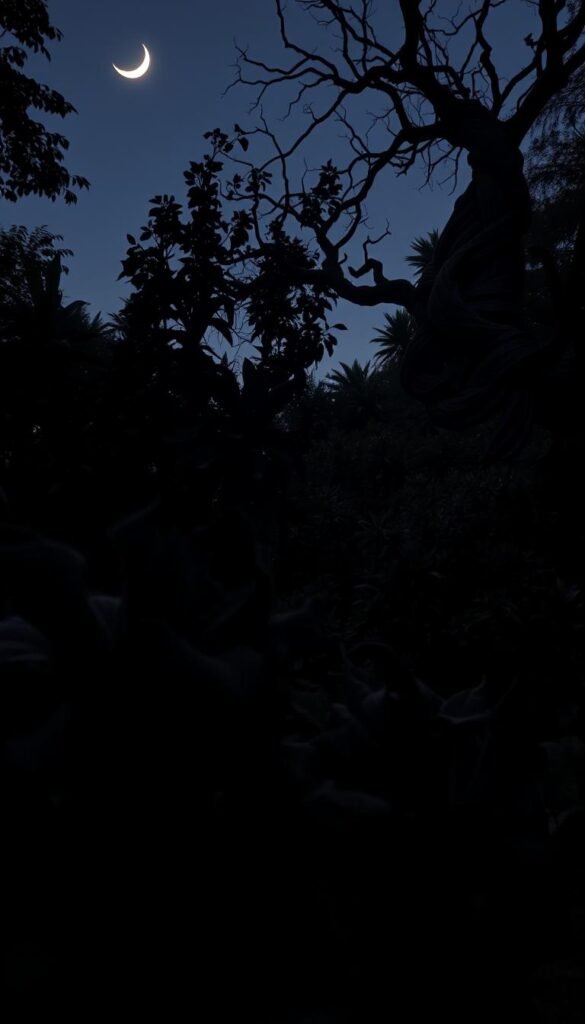
Dark-leaved specimens demand thoughtful care to maintain their dramatic appearance. Unlike traditional varieties, these inky wonders absorb more sunlight, making them both heat-sensitive and visually striking. Let’s explore how to keep your midnight-hued specimens thriving while maximizing their visual punch.
Essential Care Strategies
Your watering routine becomes crucial during summer heatwaves. Dark petals act like solar panels, requiring extra hydration to prevent wilting. Consider installing drip irrigation for consistent moisture without wetting delicate foliage.
Deadheading takes on new importance with these showstoppers. Remove spent blooms weekly to encourage fresh flowers and prevent energy waste. As master gardener Elena Carter advises: “Treat each clipped stem as an invitation for new performance art.”
Nutrition matters for maintaining rich coloration. Feed specimens monthly with 10-10-10 fertilizer during active growth periods. Combine this with organic mulch to regulate soil temperature and reduce water evaporation.
Design Secrets for Maximum Impact
Group specimens in clusters of three or five near light-colored stones or pale pavers. This arrangement creates natural focal points while showcasing texture contrasts. For evening drama, position dark beauties where sunset rays backlight their silhouettes.
Stay vigilant against pests attracted to tender dark foliage. Check leaf undersides weekly and use neem oil sprays at first sign of infestation. Companion planting with aromatic herbs like lavender helps deter unwanted visitors naturally.
Remember: successful displays balance maintenance with bold choices. When you give these unique plants proper care, they reward you with season-long sophistication that evolves with shifting daylight.
Exploring Unique Varieties: From Black Velvet Petunias to Queen of Night Tulips
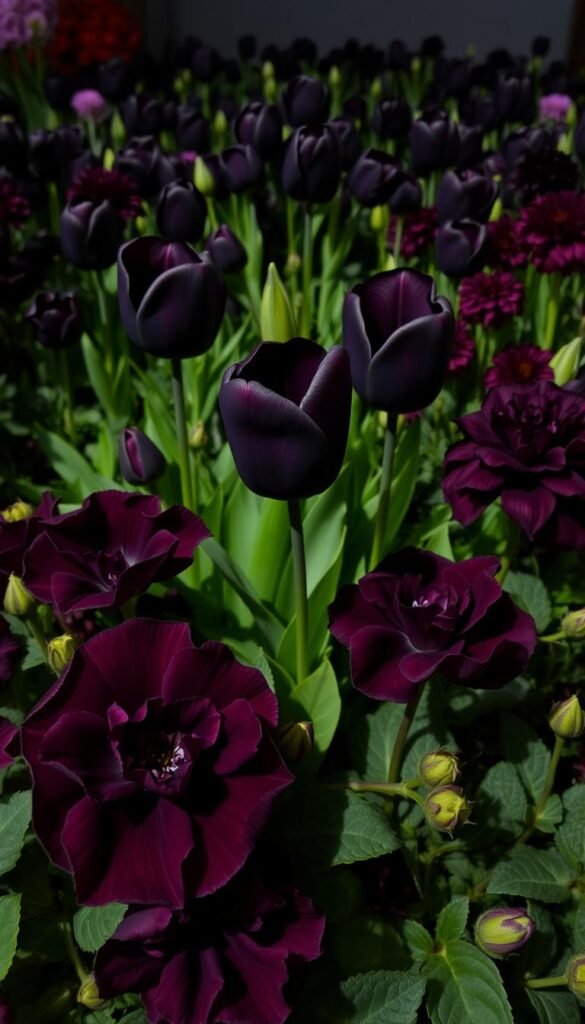
Your garden becomes a living gallery when you mix rare specimens with textural foliage. These extraordinary plants offer more than color – they create shifting moods through their forms and growing habits.
Top Flower Picks and Their Features
Meet the Black Velvet petunia – a showstopper with deep purple blooms that last from spring until frost. Its velvety texture pairs perfectly with silver-leaved companions in containers. For vertical drama, try Queen of Night tulips. Their maroon petals appear almost black when backlit by morning sun.
Chocolate cosmos adds sensory appeal with burgundy flowers that release cocoa-like scents. One gardener notes: “Visitors always lean in for a sniff – it’s nature’s perfect conversation starter.”
Highlighting Foliage with a Dark Twist
Black Magic elephant ear steals attention with glossy, heart-shaped leaves reaching 6 feet tall. Pair it with delicate black mondo grass for striking texture contrast. Both thrive in sunny spots with moist soil.
- Black Pearl pepper: Jet-black leaves + colorful fruits
- Ornamental millet: Feathery plumes + architectural height
- Persian shield: Iridescent purple-black foliage
These dark-leaved wonders maintain visual interest even when not in bloom. Use them as living bookends between brighter flowers or as standalone focal points.
Seasonal Blooms: From Late Spring to Early Fall
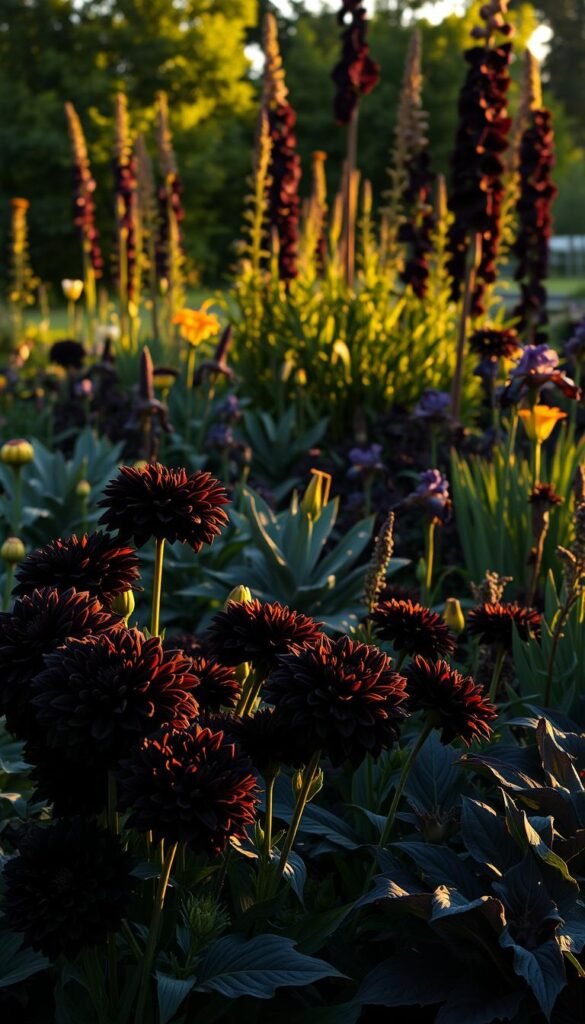
Unlock nature’s timetable by orchestrating blooms that transition seamlessly from cool spring mornings to warm autumn evenings. Your dark-themed landscape becomes a living calendar, with each plant marking time through its unique flowering rhythm.
Understanding Blooming Cycles
Start with Black Devil pansies in early spring – their frost-tolerant blooms create striking contrasts against lingering snow. As temperatures rise, Queen of Night tulips emerge with velvet-textured petals perfect for cutting. By late spring, Black Parrot tulips unfurl their feathered edges like nature’s lacework.
Summer brings heat-loving performers:
| Plant | Bloom Period | Care Tip |
|---|---|---|
| Black Magic Hollyhock | June-August | Stake tall stems |
| Black Velvet Petunia | May-Frost | Deadhead weekly |
| Chocolate Cosmos | August-October | Water deeply |
How to Maintain Your Garden Through the Seasons
Spring demands bulb planting and pansy placement in cool soil. Come summer, focus on daily hydration checks – dark petals absorb more heat. Master gardener Lila Nguyen advises: “Mulch in June to keep roots cooler than their dramatic appearance suggests.”
Autumn calls for cosmos deadheading and tulip bulb storage. Mix perennial varieties like black-eyed Susans with annuals for effortless succession. This strategy ensures some flowers return while letting you experiment with new cultivars each year.
Balancing Colors: Pairing Dark Blooms with Vibrant Accents
Your dark-hued garden becomes a masterpiece when you play with contrast. Like a skilled painter blending shades, combine midnight-colored flowers with bright companions to create visual harmony. The secret lies in using light and texture to make both elements shine.
Complementary Hues and Foliage Ideas
Try pairing inky hellebores with lemon-yellow coreopsis – the combo makes both colors appear more intense. Silver-leafed plants like artemisia act as neutral buffers between bold tones. For evening drama, position white nicotiana behind black hollyhocks to catch moonlight.
Add depth with metallic accents in copper planters or pewter garden sculptures. These touches reflect sunlight while tying your design together. Remember to repeat key colors in different areas for a cohesive look.
Balance bold red celosia with deep purple salvias for fiery energy. Soften edges with feathery grasses in champagne hues. Your garden becomes a living color wheel where dark foliage grounds vibrant blooms, creating moments of surprise at every turn.

